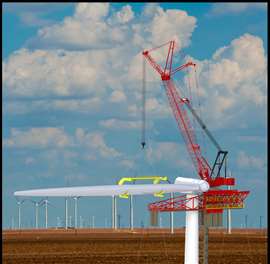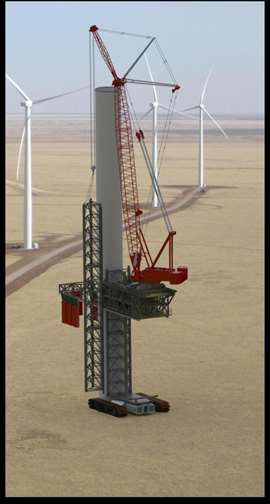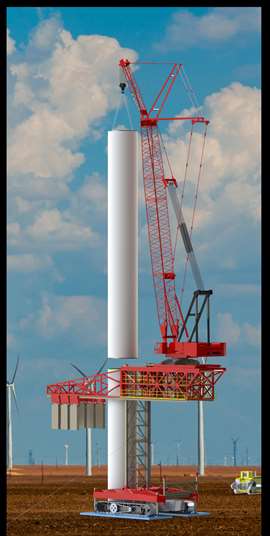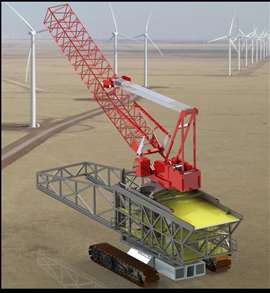Smaller cranes to build bigger turbines
27 November 2023
DWLS promises safer and more efficient erection and maintenance of larger wind turbines using a 300 tonne crane instead of a more typical 1,000 tonner. Alex Dahm reports.
 Davis Wind Lift System (DWLS) promises financial and operational advantages over competing wind turbine installation methods. Image: DWLS
Davis Wind Lift System (DWLS) promises financial and operational advantages over competing wind turbine installation methods. Image: DWLS
A new way of erecting wind turbines, both on and offshore, is on its way from Davis Wind Lift System (DWLS) in the USA, writes Alex Dahm.
DWLS promises safer and more efficient erection and maintenance of larger wind turbines using a 300 tonne crane instead of a more typical 1,000 tonner.
Key to its concept is for it to be safer and go higher for less money than conventional methods. As turbines get taller and components get heavier existing large crawler and lattice truck cranes are being pushed to their limits.
The new DWLS system, however, only needs a 300 US ton (272 tonne) capacity crane to erect turbines with 165 metre tower heights and beyond. It is safer, can reach much greater tower heights, takes less time per tower and saves money both in cost per tower and capital cost for the equipment, the company said.
Further benefits claimed for the patented DWLS system include lower transport and logistics costs in that it can be moved on 30 per cent fewer trucks with far fewer permit loads. Civil engineering costs are also lower as it does not need the traditional crane pad.
 Projections show the DW165 will be able to install 85 turbines in the time taken for a 1,000 tonne crawler crane to build 75. Image: DWLS
Projections show the DW165 will be able to install 85 turbines in the time taken for a 1,000 tonne crawler crane to build 75. Image: DWLS
Potential savings
Calculations provided by DWLS show that using its system instead of a 1,000 tonne capacity crawler crane saves US$200,000 or more per tower, on the logistics and civils work alone. This equates to 20 % of those costs, or 7 % of the total project cost.
DWLS is the brainchild of crane, construction and offshore oil industry veteran of more than 40 years, Danny Davis. As an entrepreneur and inventor Davis has worked for major crane and construction equipment manufacturers, including Manitowoc, Favelle Favco, Volvo and Caterpillar. He holds multiple patents.
Working alongside Davis helping to make it a reality is Jim Hopkins, DWLS general manager and longtime construction, mining and crane industry expert with decades of experience gained at Caterpillar, Volvo, Terex, Bucyrus and others.
A prototype DW165 system was under construction at the time of writing in late October and on schedule for field testing to begin in mid-2024. It will use a 272 tonne capacity lattice crawler crane upper operating from a 130 metre climbing mast to erect 4.5 MW turbines. In this same configuration it will be able to lift and set even higher, to 165 metres, because of the crane’s boom at 36 metres long. Hook height on the jib from the ground will be 182 metres.
Millions of dollars have been invested in the project, engineers are working on final details, long lead-time components have been ordered and steel is being fabricated, Davis said. “This is a game changer,” he promised.
Wind turbine manufacturers, developers and construction companies are being targeted but DWLS is also pitching this as a way into the turbine erection business for smaller companies that don’t have 1,000 tonne capacity cranes.
How does it work?
 The Davis Wind Lift System uses a 300 US ton (272 tonne) capacity lattice boom crawler crane mounted on a tower lift system to install wind turbines with 165 metre towers and higher. Image: DWLS
The Davis Wind Lift System uses a 300 US ton (272 tonne) capacity lattice boom crawler crane mounted on a tower lift system to install wind turbines with 165 metre towers and higher. Image: DWLS
A large self propelled crawler transporter with 1.83 metre wide tracks forms the base of the DWLS system. It offers high tractive effort and flotation to move between turbines. At the turbine site the unit is positioned on steel mats and set up with four levelling jacks, one at each end of the crawler frames, to position it plumb with the wind tower. Ground bearing pressure in operation is 10.5 psi but can be as little as 8 psi, Hopkins said.
The triangular lattice climbing mast is similar in design to the leg of a jack up vessel used in the offshore oil and gas industry. It uses identical planetary drives, brakes and pinions and is designed and approved to the same demanding safety and regulatory requirements as the offshore jacking application.
The climbing platform is connected to the mast via the double cut rack and pinions and is restrained and guided through slide pads. The mast construction is pinned at each joint and further secured with flanges and bolts similar to crane mast construction. The rate of climb is 4 metres a minute and it can be brought down more quickly.
The system is secured to the wind tower at every tower flange using high tensile strength synthetic fibre slings. Non-abrasive sheaths enclose the slings to prevent damage to the painted surface of the turbine tower. Tension forces are held below any level that would distort or damage the flange.
In addition to the slings, four dozer tractors with winches are tethered to the corners of the climbing frame to neutralise wind forces.
Crane position is adjusted hydraulically on a sliding base on the 40 metre long climbing frame. Movements are managed using a PLC with moving counterweights on the opposite side of the tower to maintain equilibrium.
Ideal position
The crane on the DW165 prototype is a 300 US ton (272 tonne) capacity Manitowoc 2250 with its crawler undercarriage removed. Any make of crawler crane can be used and DWLS is an independent business not affiliated or working with Manitowoc. The crane’s boom is reinforced to include provision for a high capacity main hoist winch mounted on top of the butt section. A custom-designed heavy jib fixed at 20 degrees offset is used.
Swing radius for all the major lifts is less than 15 metres, Jim Hopkins explains, allowing lifts to be staged from the load area close to the tower base. This keeps them in the sweet spot of the crane’s lifting chart. Boom angles are maintained between 80 and 84 degrees for all major lifts. To change the operating radius the crane is moved on its sliding base towards or away from the tower instead of booming in or out.
Different configurations of the DWLS will be available, including versions to be mounted on jack up vessels or ocean platforms for offshore turbine installation.
Early adopters are being sought to take on the new DWLS system and sites are required for testing and evaluation of the patented design. “It offers strong financial and operational advantages versus using large crawler cranes,” Davis said.
 DWLS puts wind turbine erection within reach of companies that don’t own or manufacture 750, 1,000 tonne or bigger lattice cranes. Image: DWLS
DWLS puts wind turbine erection within reach of companies that don’t own or manufacture 750, 1,000 tonne or bigger lattice cranes. Image: DWLS
STAY CONNECTED


Receive the information you need when you need it through our world-leading magazines, newsletters and daily briefings.
CONNECT WITH THE TEAM








